An Analysis of Ethics in Circular Economy for Sustainable Business
VerifiedAdded on 2020/12/09
|10
|3593
|384
Report
AI Summary
This report delves into the concept of circular economy and its significance in fostering sustainable business practices, particularly within the fashion industry. It begins by defining circular economy and tracing its theoretical roots, highlighting its role in maximizing resource utilization and minimizing waste. The report then explores the relationship between circular economy and sustainable business initiatives, emphasizing the principles outlined in the Sustainable Fashion Blueprint. A key component involves an analysis of Marks and Spencer, a UK fashion brand, and its alignment with sustainable business practices and the British Fashion Council's Positive Fashion Strategy. The report provides an overview of Marks and Spencer's contributions to the fashion industry, including its impact on the democratization of fashion. Finally, the report concludes with recommendations based on Marks and Spencer's performance against sustainable business initiatives, reflecting the British Fashion Council's Positive Fashion Strategy.
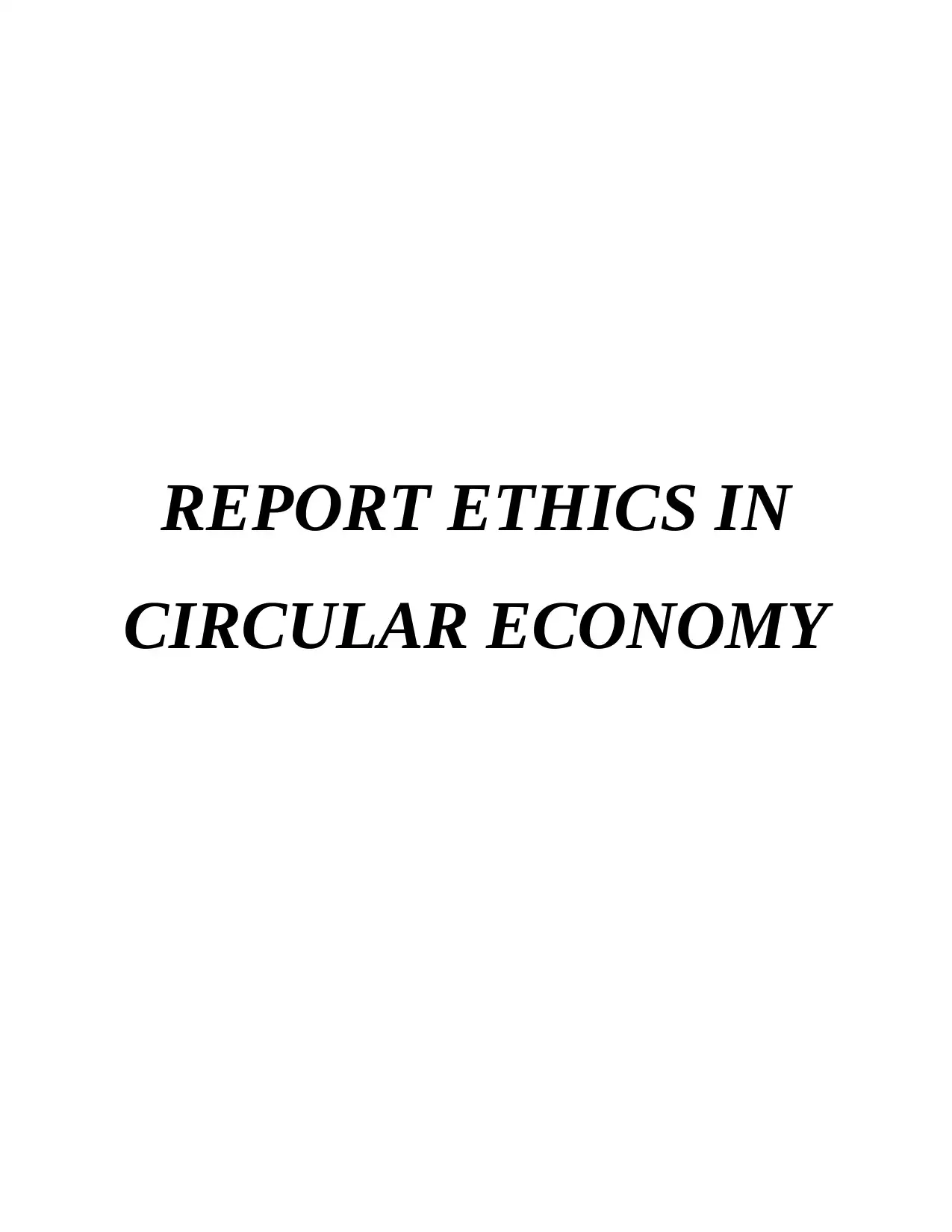
REPORT ETHICS IN
CIRCULAR ECONOMY
CIRCULAR ECONOMY
Paraphrase This Document
Need a fresh take? Get an instant paraphrase of this document with our AI Paraphraser
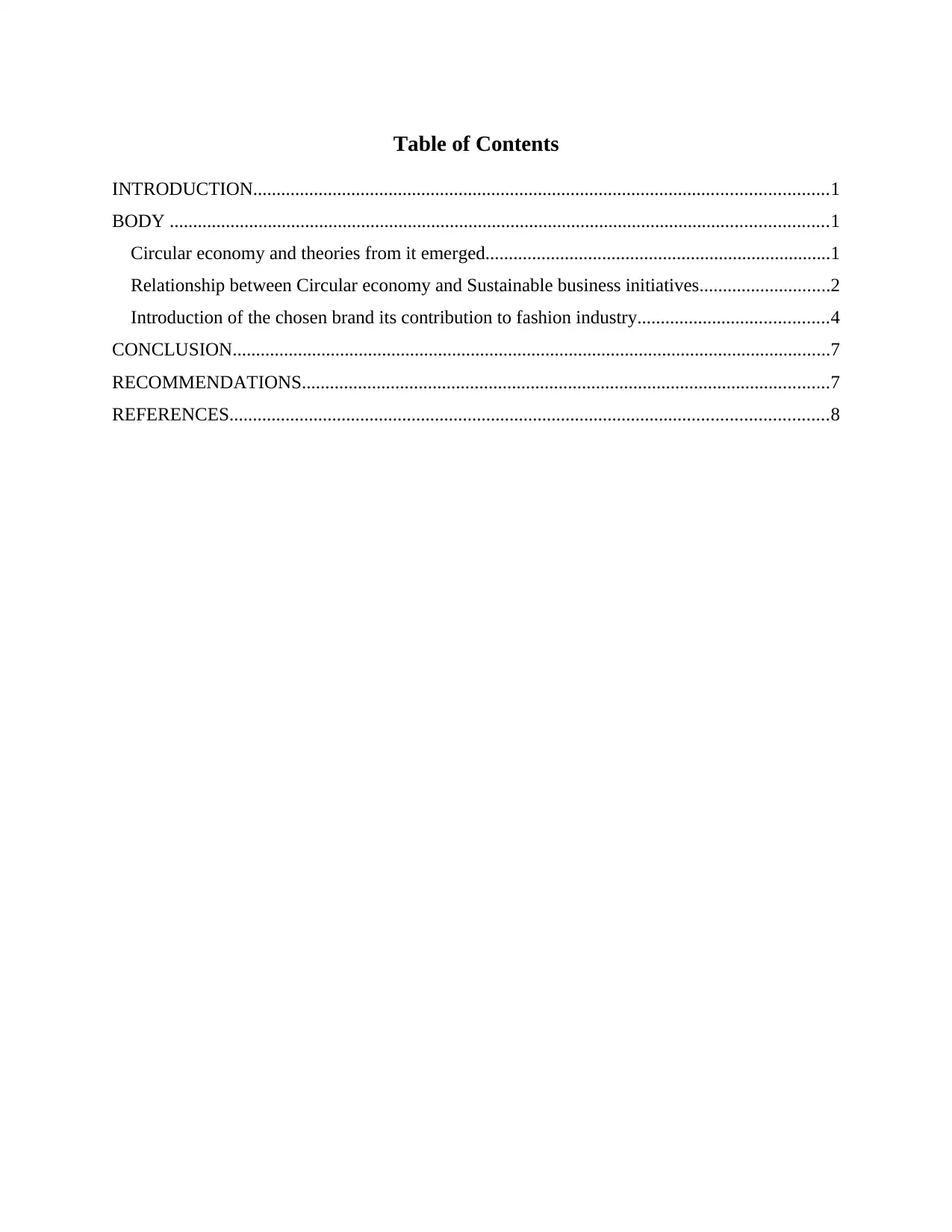
Table of Contents
INTRODUCTION...........................................................................................................................1
BODY .............................................................................................................................................1
Circular economy and theories from it emerged..........................................................................1
Relationship between Circular economy and Sustainable business initiatives............................2
Introduction of the chosen brand its contribution to fashion industry.........................................4
CONCLUSION................................................................................................................................7
RECOMMENDATIONS.................................................................................................................7
REFERENCES................................................................................................................................8
INTRODUCTION...........................................................................................................................1
BODY .............................................................................................................................................1
Circular economy and theories from it emerged..........................................................................1
Relationship between Circular economy and Sustainable business initiatives............................2
Introduction of the chosen brand its contribution to fashion industry.........................................4
CONCLUSION................................................................................................................................7
RECOMMENDATIONS.................................................................................................................7
REFERENCES................................................................................................................................8
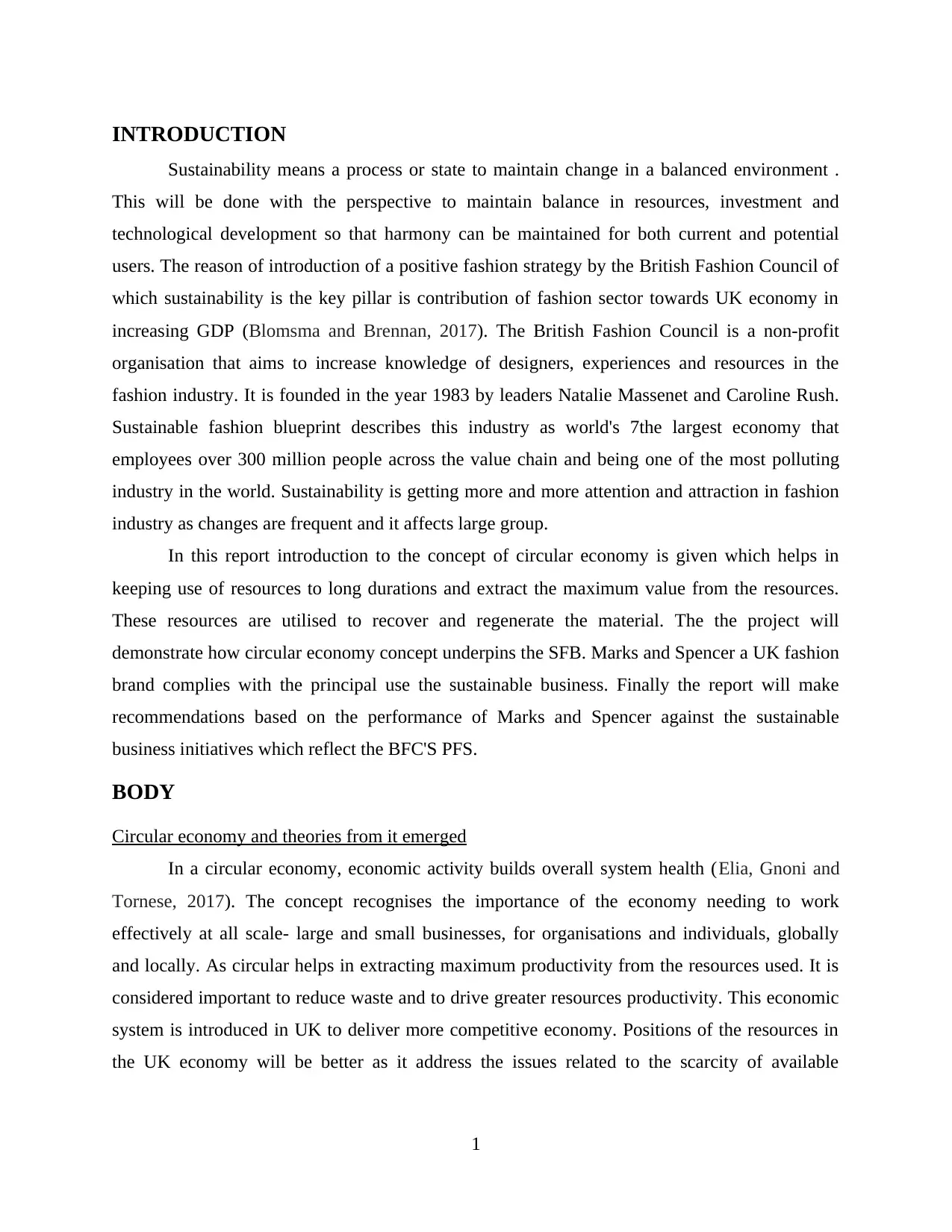
INTRODUCTION
Sustainability means a process or state to maintain change in a balanced environment .
This will be done with the perspective to maintain balance in resources, investment and
technological development so that harmony can be maintained for both current and potential
users. The reason of introduction of a positive fashion strategy by the British Fashion Council of
which sustainability is the key pillar is contribution of fashion sector towards UK economy in
increasing GDP (Blomsma and Brennan, 2017). The British Fashion Council is a non-profit
organisation that aims to increase knowledge of designers, experiences and resources in the
fashion industry. It is founded in the year 1983 by leaders Natalie Massenet and Caroline Rush.
Sustainable fashion blueprint describes this industry as world's 7the largest economy that
employees over 300 million people across the value chain and being one of the most polluting
industry in the world. Sustainability is getting more and more attention and attraction in fashion
industry as changes are frequent and it affects large group.
In this report introduction to the concept of circular economy is given which helps in
keeping use of resources to long durations and extract the maximum value from the resources.
These resources are utilised to recover and regenerate the material. The the project will
demonstrate how circular economy concept underpins the SFB. Marks and Spencer a UK fashion
brand complies with the principal use the sustainable business. Finally the report will make
recommendations based on the performance of Marks and Spencer against the sustainable
business initiatives which reflect the BFC'S PFS.
BODY
Circular economy and theories from it emerged
In a circular economy, economic activity builds overall system health (Elia, Gnoni and
Tornese, 2017). The concept recognises the importance of the economy needing to work
effectively at all scale- large and small businesses, for organisations and individuals, globally
and locally. As circular helps in extracting maximum productivity from the resources used. It is
considered important to reduce waste and to drive greater resources productivity. This economic
system is introduced in UK to deliver more competitive economy. Positions of the resources in
the UK economy will be better as it address the issues related to the scarcity of available
1
Sustainability means a process or state to maintain change in a balanced environment .
This will be done with the perspective to maintain balance in resources, investment and
technological development so that harmony can be maintained for both current and potential
users. The reason of introduction of a positive fashion strategy by the British Fashion Council of
which sustainability is the key pillar is contribution of fashion sector towards UK economy in
increasing GDP (Blomsma and Brennan, 2017). The British Fashion Council is a non-profit
organisation that aims to increase knowledge of designers, experiences and resources in the
fashion industry. It is founded in the year 1983 by leaders Natalie Massenet and Caroline Rush.
Sustainable fashion blueprint describes this industry as world's 7the largest economy that
employees over 300 million people across the value chain and being one of the most polluting
industry in the world. Sustainability is getting more and more attention and attraction in fashion
industry as changes are frequent and it affects large group.
In this report introduction to the concept of circular economy is given which helps in
keeping use of resources to long durations and extract the maximum value from the resources.
These resources are utilised to recover and regenerate the material. The the project will
demonstrate how circular economy concept underpins the SFB. Marks and Spencer a UK fashion
brand complies with the principal use the sustainable business. Finally the report will make
recommendations based on the performance of Marks and Spencer against the sustainable
business initiatives which reflect the BFC'S PFS.
BODY
Circular economy and theories from it emerged
In a circular economy, economic activity builds overall system health (Elia, Gnoni and
Tornese, 2017). The concept recognises the importance of the economy needing to work
effectively at all scale- large and small businesses, for organisations and individuals, globally
and locally. As circular helps in extracting maximum productivity from the resources used. It is
considered important to reduce waste and to drive greater resources productivity. This economic
system is introduced in UK to deliver more competitive economy. Positions of the resources in
the UK economy will be better as it address the issues related to the scarcity of available
1
⊘ This is a preview!⊘
Do you want full access?
Subscribe today to unlock all pages.

Trusted by 1+ million students worldwide
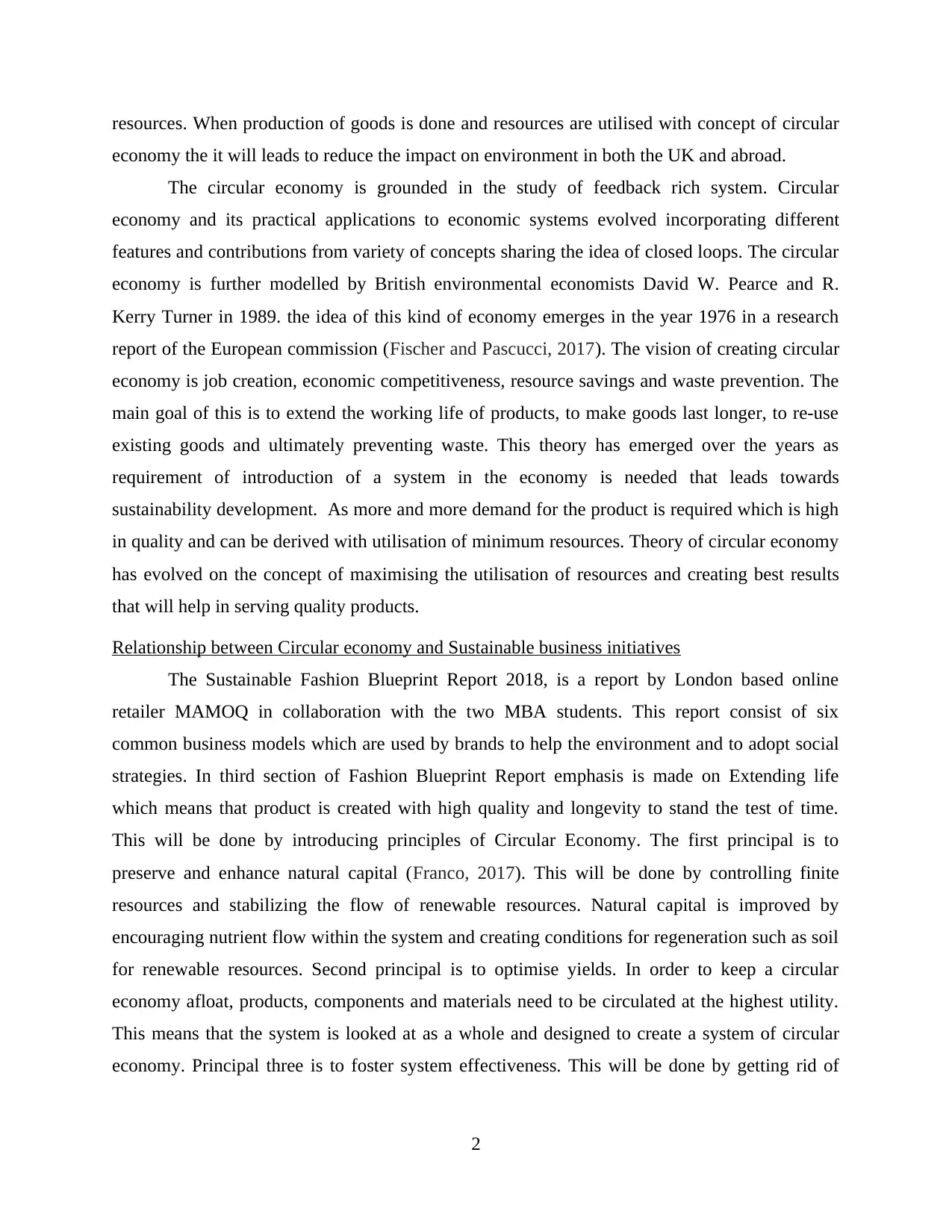
resources. When production of goods is done and resources are utilised with concept of circular
economy the it will leads to reduce the impact on environment in both the UK and abroad.
The circular economy is grounded in the study of feedback rich system. Circular
economy and its practical applications to economic systems evolved incorporating different
features and contributions from variety of concepts sharing the idea of closed loops. The circular
economy is further modelled by British environmental economists David W. Pearce and R.
Kerry Turner in 1989. the idea of this kind of economy emerges in the year 1976 in a research
report of the European commission (Fischer and Pascucci, 2017). The vision of creating circular
economy is job creation, economic competitiveness, resource savings and waste prevention. The
main goal of this is to extend the working life of products, to make goods last longer, to re-use
existing goods and ultimately preventing waste. This theory has emerged over the years as
requirement of introduction of a system in the economy is needed that leads towards
sustainability development. As more and more demand for the product is required which is high
in quality and can be derived with utilisation of minimum resources. Theory of circular economy
has evolved on the concept of maximising the utilisation of resources and creating best results
that will help in serving quality products.
Relationship between Circular economy and Sustainable business initiatives
The Sustainable Fashion Blueprint Report 2018, is a report by London based online
retailer MAMOQ in collaboration with the two MBA students. This report consist of six
common business models which are used by brands to help the environment and to adopt social
strategies. In third section of Fashion Blueprint Report emphasis is made on Extending life
which means that product is created with high quality and longevity to stand the test of time.
This will be done by introducing principles of Circular Economy. The first principal is to
preserve and enhance natural capital (Franco, 2017). This will be done by controlling finite
resources and stabilizing the flow of renewable resources. Natural capital is improved by
encouraging nutrient flow within the system and creating conditions for regeneration such as soil
for renewable resources. Second principal is to optimise yields. In order to keep a circular
economy afloat, products, components and materials need to be circulated at the highest utility.
This means that the system is looked at as a whole and designed to create a system of circular
economy. Principal three is to foster system effectiveness. This will be done by getting rid of
2
economy the it will leads to reduce the impact on environment in both the UK and abroad.
The circular economy is grounded in the study of feedback rich system. Circular
economy and its practical applications to economic systems evolved incorporating different
features and contributions from variety of concepts sharing the idea of closed loops. The circular
economy is further modelled by British environmental economists David W. Pearce and R.
Kerry Turner in 1989. the idea of this kind of economy emerges in the year 1976 in a research
report of the European commission (Fischer and Pascucci, 2017). The vision of creating circular
economy is job creation, economic competitiveness, resource savings and waste prevention. The
main goal of this is to extend the working life of products, to make goods last longer, to re-use
existing goods and ultimately preventing waste. This theory has emerged over the years as
requirement of introduction of a system in the economy is needed that leads towards
sustainability development. As more and more demand for the product is required which is high
in quality and can be derived with utilisation of minimum resources. Theory of circular economy
has evolved on the concept of maximising the utilisation of resources and creating best results
that will help in serving quality products.
Relationship between Circular economy and Sustainable business initiatives
The Sustainable Fashion Blueprint Report 2018, is a report by London based online
retailer MAMOQ in collaboration with the two MBA students. This report consist of six
common business models which are used by brands to help the environment and to adopt social
strategies. In third section of Fashion Blueprint Report emphasis is made on Extending life
which means that product is created with high quality and longevity to stand the test of time.
This will be done by introducing principles of Circular Economy. The first principal is to
preserve and enhance natural capital (Franco, 2017). This will be done by controlling finite
resources and stabilizing the flow of renewable resources. Natural capital is improved by
encouraging nutrient flow within the system and creating conditions for regeneration such as soil
for renewable resources. Second principal is to optimise yields. In order to keep a circular
economy afloat, products, components and materials need to be circulated at the highest utility.
This means that the system is looked at as a whole and designed to create a system of circular
economy. Principal three is to foster system effectiveness. This will be done by getting rid of
2
Paraphrase This Document
Need a fresh take? Get an instant paraphrase of this document with our AI Paraphraser
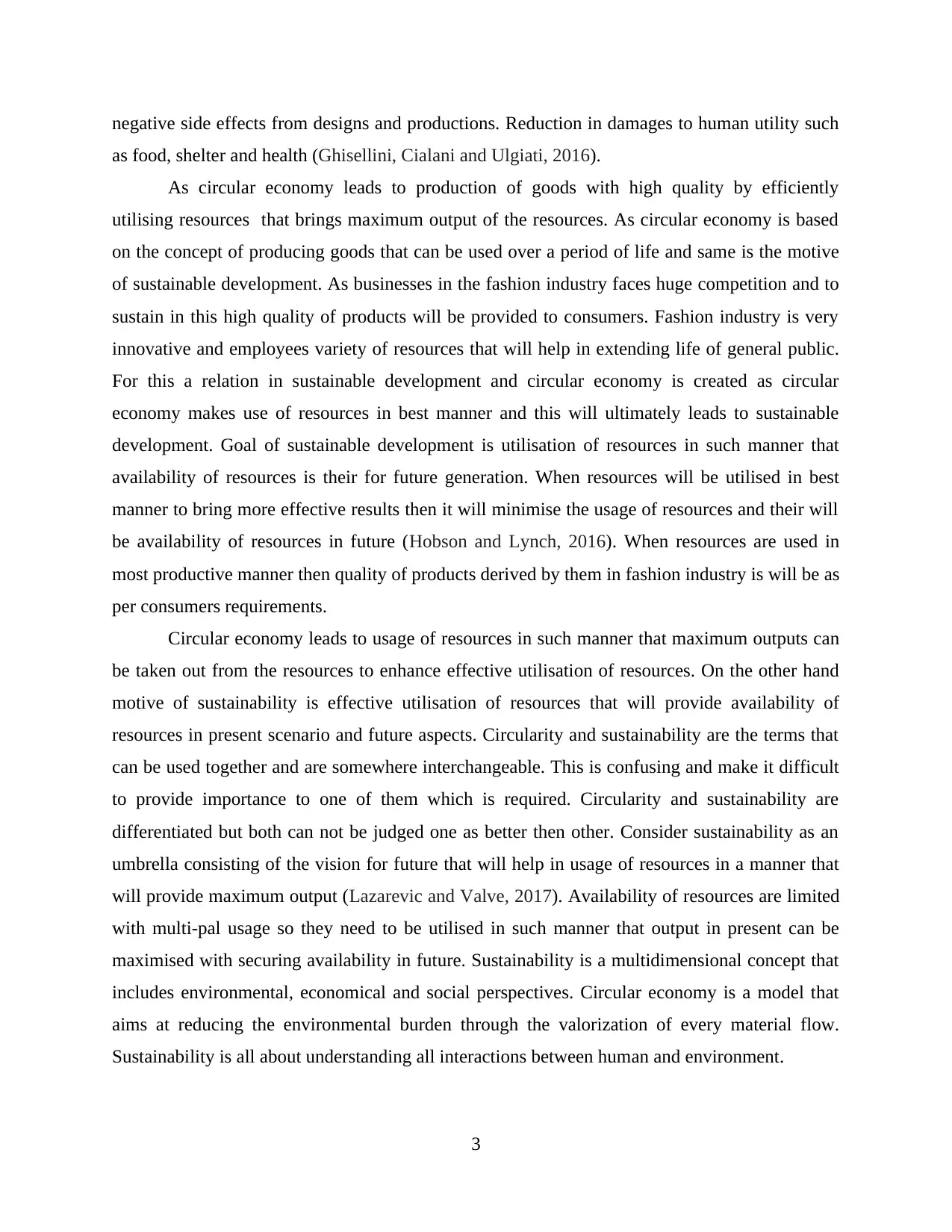
negative side effects from designs and productions. Reduction in damages to human utility such
as food, shelter and health (Ghisellini, Cialani and Ulgiati, 2016).
As circular economy leads to production of goods with high quality by efficiently
utilising resources that brings maximum output of the resources. As circular economy is based
on the concept of producing goods that can be used over a period of life and same is the motive
of sustainable development. As businesses in the fashion industry faces huge competition and to
sustain in this high quality of products will be provided to consumers. Fashion industry is very
innovative and employees variety of resources that will help in extending life of general public.
For this a relation in sustainable development and circular economy is created as circular
economy makes use of resources in best manner and this will ultimately leads to sustainable
development. Goal of sustainable development is utilisation of resources in such manner that
availability of resources is their for future generation. When resources will be utilised in best
manner to bring more effective results then it will minimise the usage of resources and their will
be availability of resources in future (Hobson and Lynch, 2016). When resources are used in
most productive manner then quality of products derived by them in fashion industry is will be as
per consumers requirements.
Circular economy leads to usage of resources in such manner that maximum outputs can
be taken out from the resources to enhance effective utilisation of resources. On the other hand
motive of sustainability is effective utilisation of resources that will provide availability of
resources in present scenario and future aspects. Circularity and sustainability are the terms that
can be used together and are somewhere interchangeable. This is confusing and make it difficult
to provide importance to one of them which is required. Circularity and sustainability are
differentiated but both can not be judged one as better then other. Consider sustainability as an
umbrella consisting of the vision for future that will help in usage of resources in a manner that
will provide maximum output (Lazarevic and Valve, 2017). Availability of resources are limited
with multi-pal usage so they need to be utilised in such manner that output in present can be
maximised with securing availability in future. Sustainability is a multidimensional concept that
includes environmental, economical and social perspectives. Circular economy is a model that
aims at reducing the environmental burden through the valorization of every material flow.
Sustainability is all about understanding all interactions between human and environment.
3
as food, shelter and health (Ghisellini, Cialani and Ulgiati, 2016).
As circular economy leads to production of goods with high quality by efficiently
utilising resources that brings maximum output of the resources. As circular economy is based
on the concept of producing goods that can be used over a period of life and same is the motive
of sustainable development. As businesses in the fashion industry faces huge competition and to
sustain in this high quality of products will be provided to consumers. Fashion industry is very
innovative and employees variety of resources that will help in extending life of general public.
For this a relation in sustainable development and circular economy is created as circular
economy makes use of resources in best manner and this will ultimately leads to sustainable
development. Goal of sustainable development is utilisation of resources in such manner that
availability of resources is their for future generation. When resources will be utilised in best
manner to bring more effective results then it will minimise the usage of resources and their will
be availability of resources in future (Hobson and Lynch, 2016). When resources are used in
most productive manner then quality of products derived by them in fashion industry is will be as
per consumers requirements.
Circular economy leads to usage of resources in such manner that maximum outputs can
be taken out from the resources to enhance effective utilisation of resources. On the other hand
motive of sustainability is effective utilisation of resources that will provide availability of
resources in present scenario and future aspects. Circularity and sustainability are the terms that
can be used together and are somewhere interchangeable. This is confusing and make it difficult
to provide importance to one of them which is required. Circularity and sustainability are
differentiated but both can not be judged one as better then other. Consider sustainability as an
umbrella consisting of the vision for future that will help in usage of resources in a manner that
will provide maximum output (Lazarevic and Valve, 2017). Availability of resources are limited
with multi-pal usage so they need to be utilised in such manner that output in present can be
maximised with securing availability in future. Sustainability is a multidimensional concept that
includes environmental, economical and social perspectives. Circular economy is a model that
aims at reducing the environmental burden through the valorization of every material flow.
Sustainability is all about understanding all interactions between human and environment.
3
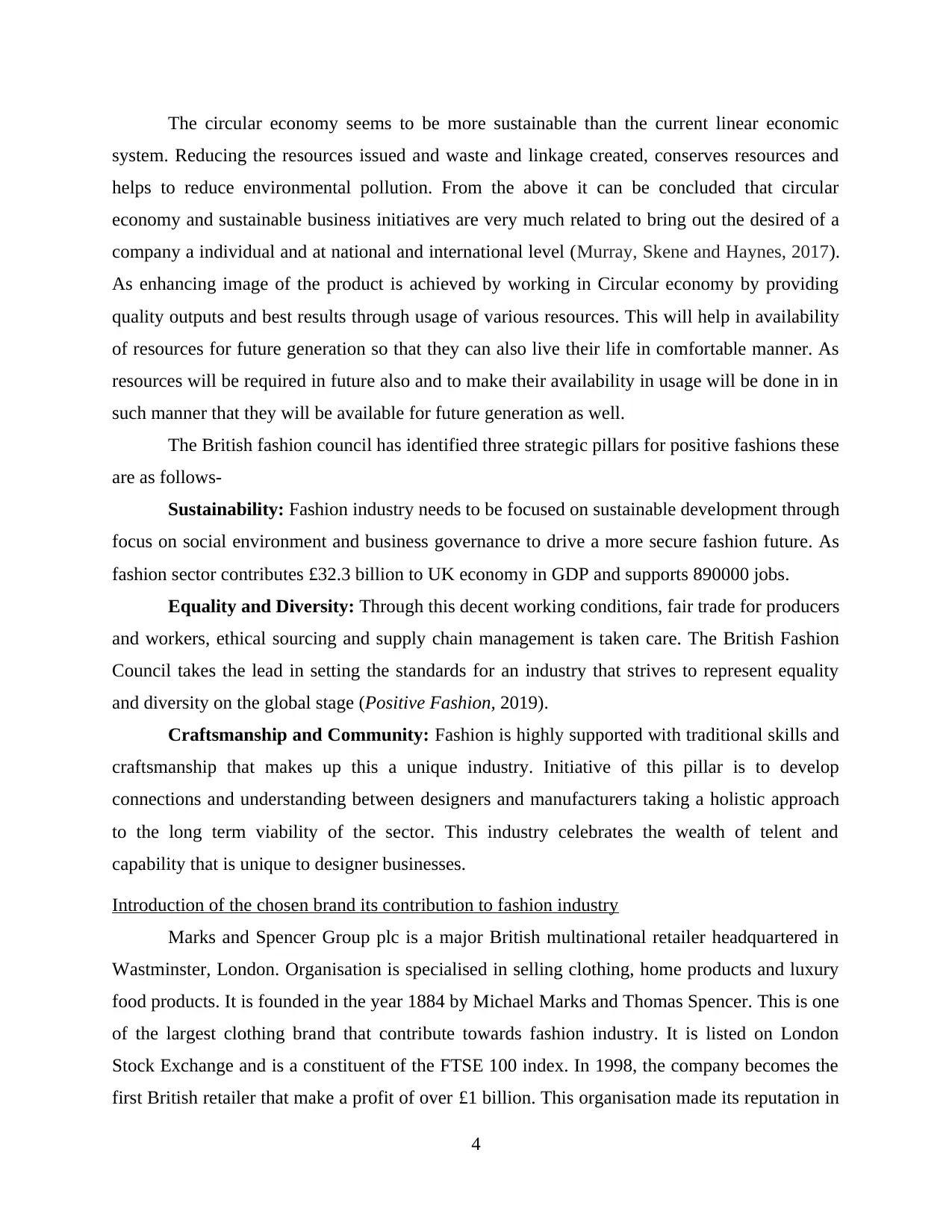
The circular economy seems to be more sustainable than the current linear economic
system. Reducing the resources issued and waste and linkage created, conserves resources and
helps to reduce environmental pollution. From the above it can be concluded that circular
economy and sustainable business initiatives are very much related to bring out the desired of a
company a individual and at national and international level (Murray, Skene and Haynes, 2017).
As enhancing image of the product is achieved by working in Circular economy by providing
quality outputs and best results through usage of various resources. This will help in availability
of resources for future generation so that they can also live their life in comfortable manner. As
resources will be required in future also and to make their availability in usage will be done in in
such manner that they will be available for future generation as well.
The British fashion council has identified three strategic pillars for positive fashions these
are as follows-
Sustainability: Fashion industry needs to be focused on sustainable development through
focus on social environment and business governance to drive a more secure fashion future. As
fashion sector contributes £32.3 billion to UK economy in GDP and supports 890000 jobs.
Equality and Diversity: Through this decent working conditions, fair trade for producers
and workers, ethical sourcing and supply chain management is taken care. The British Fashion
Council takes the lead in setting the standards for an industry that strives to represent equality
and diversity on the global stage (Positive Fashion, 2019).
Craftsmanship and Community: Fashion is highly supported with traditional skills and
craftsmanship that makes up this a unique industry. Initiative of this pillar is to develop
connections and understanding between designers and manufacturers taking a holistic approach
to the long term viability of the sector. This industry celebrates the wealth of telent and
capability that is unique to designer businesses.
Introduction of the chosen brand its contribution to fashion industry
Marks and Spencer Group plc is a major British multinational retailer headquartered in
Wastminster, London. Organisation is specialised in selling clothing, home products and luxury
food products. It is founded in the year 1884 by Michael Marks and Thomas Spencer. This is one
of the largest clothing brand that contribute towards fashion industry. It is listed on London
Stock Exchange and is a constituent of the FTSE 100 index. In 1998, the company becomes the
first British retailer that make a profit of over £1 billion. This organisation made its reputation in
4
system. Reducing the resources issued and waste and linkage created, conserves resources and
helps to reduce environmental pollution. From the above it can be concluded that circular
economy and sustainable business initiatives are very much related to bring out the desired of a
company a individual and at national and international level (Murray, Skene and Haynes, 2017).
As enhancing image of the product is achieved by working in Circular economy by providing
quality outputs and best results through usage of various resources. This will help in availability
of resources for future generation so that they can also live their life in comfortable manner. As
resources will be required in future also and to make their availability in usage will be done in in
such manner that they will be available for future generation as well.
The British fashion council has identified three strategic pillars for positive fashions these
are as follows-
Sustainability: Fashion industry needs to be focused on sustainable development through
focus on social environment and business governance to drive a more secure fashion future. As
fashion sector contributes £32.3 billion to UK economy in GDP and supports 890000 jobs.
Equality and Diversity: Through this decent working conditions, fair trade for producers
and workers, ethical sourcing and supply chain management is taken care. The British Fashion
Council takes the lead in setting the standards for an industry that strives to represent equality
and diversity on the global stage (Positive Fashion, 2019).
Craftsmanship and Community: Fashion is highly supported with traditional skills and
craftsmanship that makes up this a unique industry. Initiative of this pillar is to develop
connections and understanding between designers and manufacturers taking a holistic approach
to the long term viability of the sector. This industry celebrates the wealth of telent and
capability that is unique to designer businesses.
Introduction of the chosen brand its contribution to fashion industry
Marks and Spencer Group plc is a major British multinational retailer headquartered in
Wastminster, London. Organisation is specialised in selling clothing, home products and luxury
food products. It is founded in the year 1884 by Michael Marks and Thomas Spencer. This is one
of the largest clothing brand that contribute towards fashion industry. It is listed on London
Stock Exchange and is a constituent of the FTSE 100 index. In 1998, the company becomes the
first British retailer that make a profit of over £1 billion. This organisation made its reputation in
4
⊘ This is a preview!⊘
Do you want full access?
Subscribe today to unlock all pages.

Trusted by 1+ million students worldwide
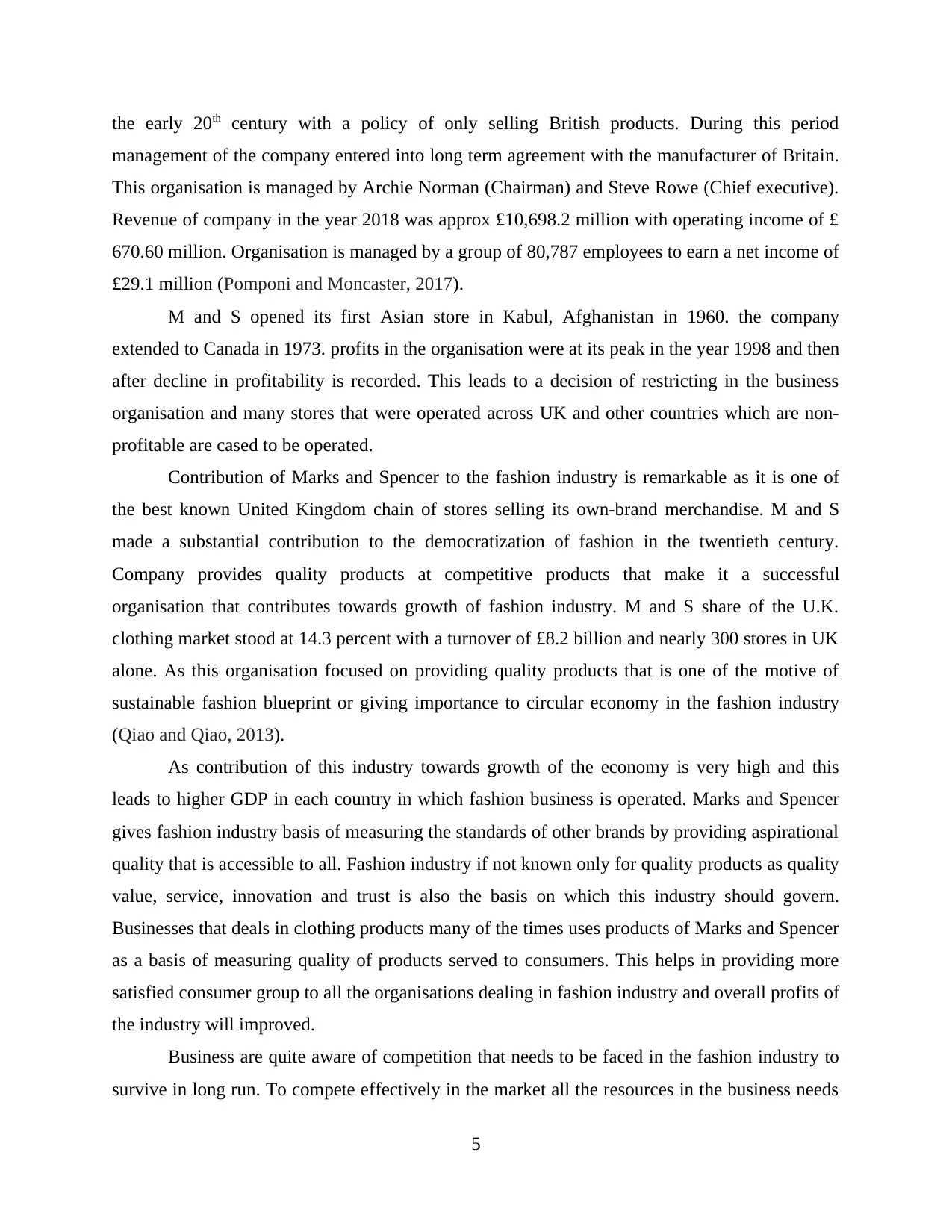
the early 20th century with a policy of only selling British products. During this period
management of the company entered into long term agreement with the manufacturer of Britain.
This organisation is managed by Archie Norman (Chairman) and Steve Rowe (Chief executive).
Revenue of company in the year 2018 was approx £10,698.2 million with operating income of £
670.60 million. Organisation is managed by a group of 80,787 employees to earn a net income of
£29.1 million (Pomponi and Moncaster, 2017).
M and S opened its first Asian store in Kabul, Afghanistan in 1960. the company
extended to Canada in 1973. profits in the organisation were at its peak in the year 1998 and then
after decline in profitability is recorded. This leads to a decision of restricting in the business
organisation and many stores that were operated across UK and other countries which are non-
profitable are cased to be operated.
Contribution of Marks and Spencer to the fashion industry is remarkable as it is one of
the best known United Kingdom chain of stores selling its own-brand merchandise. M and S
made a substantial contribution to the democratization of fashion in the twentieth century.
Company provides quality products at competitive products that make it a successful
organisation that contributes towards growth of fashion industry. M and S share of the U.K.
clothing market stood at 14.3 percent with a turnover of £8.2 billion and nearly 300 stores in UK
alone. As this organisation focused on providing quality products that is one of the motive of
sustainable fashion blueprint or giving importance to circular economy in the fashion industry
(Qiao and Qiao, 2013).
As contribution of this industry towards growth of the economy is very high and this
leads to higher GDP in each country in which fashion business is operated. Marks and Spencer
gives fashion industry basis of measuring the standards of other brands by providing aspirational
quality that is accessible to all. Fashion industry if not known only for quality products as quality
value, service, innovation and trust is also the basis on which this industry should govern.
Businesses that deals in clothing products many of the times uses products of Marks and Spencer
as a basis of measuring quality of products served to consumers. This helps in providing more
satisfied consumer group to all the organisations dealing in fashion industry and overall profits of
the industry will improved.
Business are quite aware of competition that needs to be faced in the fashion industry to
survive in long run. To compete effectively in the market all the resources in the business needs
5
management of the company entered into long term agreement with the manufacturer of Britain.
This organisation is managed by Archie Norman (Chairman) and Steve Rowe (Chief executive).
Revenue of company in the year 2018 was approx £10,698.2 million with operating income of £
670.60 million. Organisation is managed by a group of 80,787 employees to earn a net income of
£29.1 million (Pomponi and Moncaster, 2017).
M and S opened its first Asian store in Kabul, Afghanistan in 1960. the company
extended to Canada in 1973. profits in the organisation were at its peak in the year 1998 and then
after decline in profitability is recorded. This leads to a decision of restricting in the business
organisation and many stores that were operated across UK and other countries which are non-
profitable are cased to be operated.
Contribution of Marks and Spencer to the fashion industry is remarkable as it is one of
the best known United Kingdom chain of stores selling its own-brand merchandise. M and S
made a substantial contribution to the democratization of fashion in the twentieth century.
Company provides quality products at competitive products that make it a successful
organisation that contributes towards growth of fashion industry. M and S share of the U.K.
clothing market stood at 14.3 percent with a turnover of £8.2 billion and nearly 300 stores in UK
alone. As this organisation focused on providing quality products that is one of the motive of
sustainable fashion blueprint or giving importance to circular economy in the fashion industry
(Qiao and Qiao, 2013).
As contribution of this industry towards growth of the economy is very high and this
leads to higher GDP in each country in which fashion business is operated. Marks and Spencer
gives fashion industry basis of measuring the standards of other brands by providing aspirational
quality that is accessible to all. Fashion industry if not known only for quality products as quality
value, service, innovation and trust is also the basis on which this industry should govern.
Businesses that deals in clothing products many of the times uses products of Marks and Spencer
as a basis of measuring quality of products served to consumers. This helps in providing more
satisfied consumer group to all the organisations dealing in fashion industry and overall profits of
the industry will improved.
Business are quite aware of competition that needs to be faced in the fashion industry to
survive in long run. To compete effectively in the market all the resources in the business needs
5
Paraphrase This Document
Need a fresh take? Get an instant paraphrase of this document with our AI Paraphraser
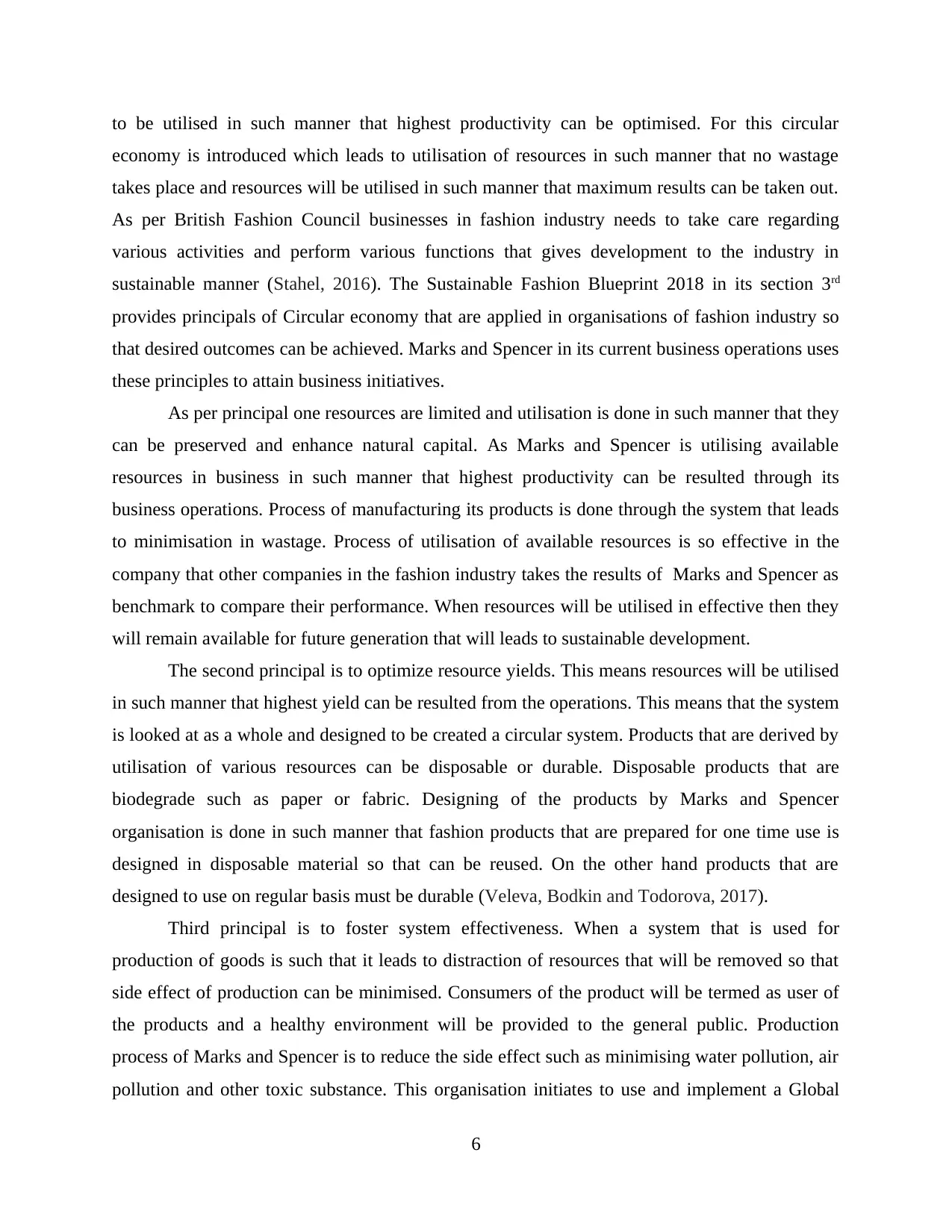
to be utilised in such manner that highest productivity can be optimised. For this circular
economy is introduced which leads to utilisation of resources in such manner that no wastage
takes place and resources will be utilised in such manner that maximum results can be taken out.
As per British Fashion Council businesses in fashion industry needs to take care regarding
various activities and perform various functions that gives development to the industry in
sustainable manner (Stahel, 2016). The Sustainable Fashion Blueprint 2018 in its section 3rd
provides principals of Circular economy that are applied in organisations of fashion industry so
that desired outcomes can be achieved. Marks and Spencer in its current business operations uses
these principles to attain business initiatives.
As per principal one resources are limited and utilisation is done in such manner that they
can be preserved and enhance natural capital. As Marks and Spencer is utilising available
resources in business in such manner that highest productivity can be resulted through its
business operations. Process of manufacturing its products is done through the system that leads
to minimisation in wastage. Process of utilisation of available resources is so effective in the
company that other companies in the fashion industry takes the results of Marks and Spencer as
benchmark to compare their performance. When resources will be utilised in effective then they
will remain available for future generation that will leads to sustainable development.
The second principal is to optimize resource yields. This means resources will be utilised
in such manner that highest yield can be resulted from the operations. This means that the system
is looked at as a whole and designed to be created a circular system. Products that are derived by
utilisation of various resources can be disposable or durable. Disposable products that are
biodegrade such as paper or fabric. Designing of the products by Marks and Spencer
organisation is done in such manner that fashion products that are prepared for one time use is
designed in disposable material so that can be reused. On the other hand products that are
designed to use on regular basis must be durable (Veleva, Bodkin and Todorova, 2017).
Third principal is to foster system effectiveness. When a system that is used for
production of goods is such that it leads to distraction of resources that will be removed so that
side effect of production can be minimised. Consumers of the product will be termed as user of
the products and a healthy environment will be provided to the general public. Production
process of Marks and Spencer is to reduce the side effect such as minimising water pollution, air
pollution and other toxic substance. This organisation initiates to use and implement a Global
6
economy is introduced which leads to utilisation of resources in such manner that no wastage
takes place and resources will be utilised in such manner that maximum results can be taken out.
As per British Fashion Council businesses in fashion industry needs to take care regarding
various activities and perform various functions that gives development to the industry in
sustainable manner (Stahel, 2016). The Sustainable Fashion Blueprint 2018 in its section 3rd
provides principals of Circular economy that are applied in organisations of fashion industry so
that desired outcomes can be achieved. Marks and Spencer in its current business operations uses
these principles to attain business initiatives.
As per principal one resources are limited and utilisation is done in such manner that they
can be preserved and enhance natural capital. As Marks and Spencer is utilising available
resources in business in such manner that highest productivity can be resulted through its
business operations. Process of manufacturing its products is done through the system that leads
to minimisation in wastage. Process of utilisation of available resources is so effective in the
company that other companies in the fashion industry takes the results of Marks and Spencer as
benchmark to compare their performance. When resources will be utilised in effective then they
will remain available for future generation that will leads to sustainable development.
The second principal is to optimize resource yields. This means resources will be utilised
in such manner that highest yield can be resulted from the operations. This means that the system
is looked at as a whole and designed to be created a circular system. Products that are derived by
utilisation of various resources can be disposable or durable. Disposable products that are
biodegrade such as paper or fabric. Designing of the products by Marks and Spencer
organisation is done in such manner that fashion products that are prepared for one time use is
designed in disposable material so that can be reused. On the other hand products that are
designed to use on regular basis must be durable (Veleva, Bodkin and Todorova, 2017).
Third principal is to foster system effectiveness. When a system that is used for
production of goods is such that it leads to distraction of resources that will be removed so that
side effect of production can be minimised. Consumers of the product will be termed as user of
the products and a healthy environment will be provided to the general public. Production
process of Marks and Spencer is to reduce the side effect such as minimising water pollution, air
pollution and other toxic substance. This organisation initiates to use and implement a Global
6
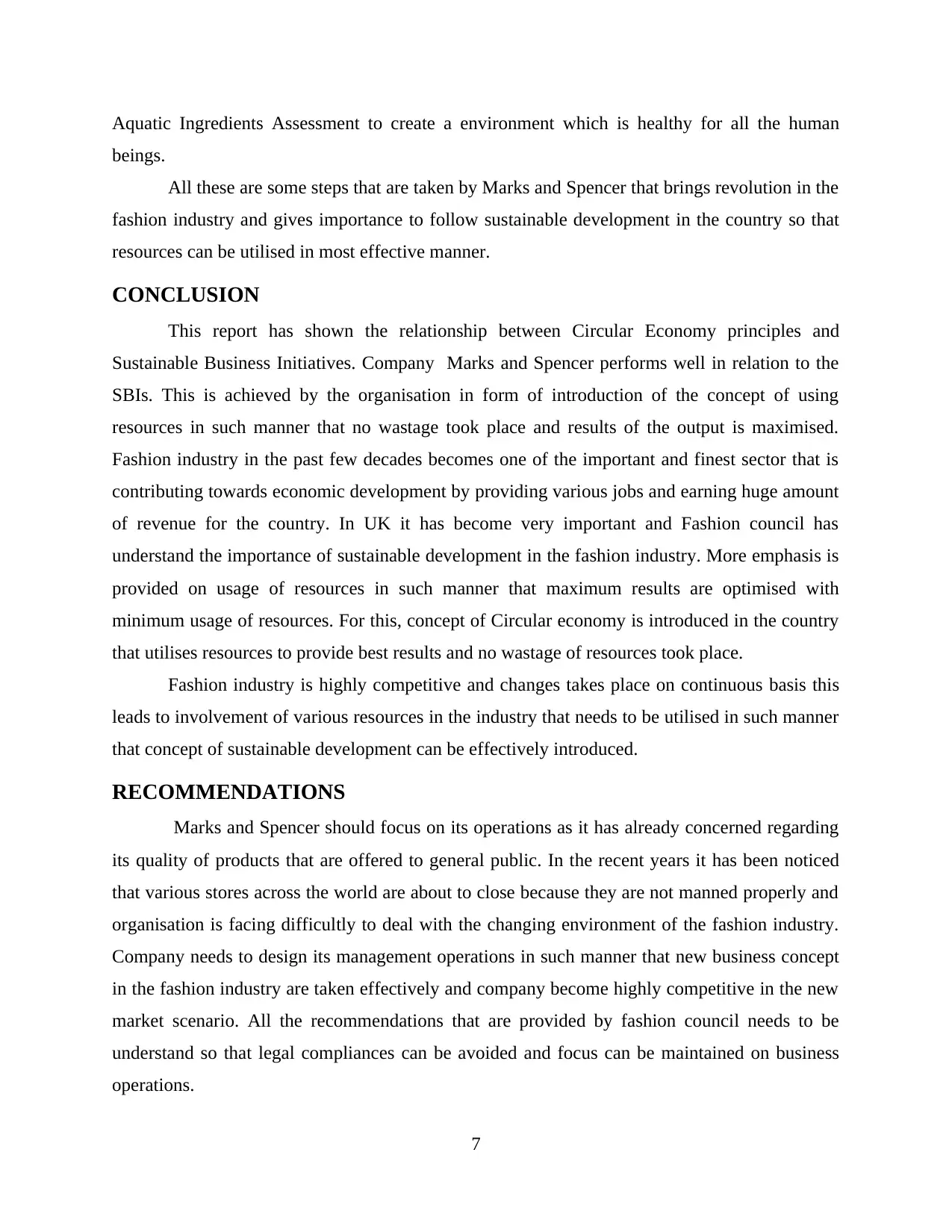
Aquatic Ingredients Assessment to create a environment which is healthy for all the human
beings.
All these are some steps that are taken by Marks and Spencer that brings revolution in the
fashion industry and gives importance to follow sustainable development in the country so that
resources can be utilised in most effective manner.
CONCLUSION
This report has shown the relationship between Circular Economy principles and
Sustainable Business Initiatives. Company Marks and Spencer performs well in relation to the
SBIs. This is achieved by the organisation in form of introduction of the concept of using
resources in such manner that no wastage took place and results of the output is maximised.
Fashion industry in the past few decades becomes one of the important and finest sector that is
contributing towards economic development by providing various jobs and earning huge amount
of revenue for the country. In UK it has become very important and Fashion council has
understand the importance of sustainable development in the fashion industry. More emphasis is
provided on usage of resources in such manner that maximum results are optimised with
minimum usage of resources. For this, concept of Circular economy is introduced in the country
that utilises resources to provide best results and no wastage of resources took place.
Fashion industry is highly competitive and changes takes place on continuous basis this
leads to involvement of various resources in the industry that needs to be utilised in such manner
that concept of sustainable development can be effectively introduced.
RECOMMENDATIONS
Marks and Spencer should focus on its operations as it has already concerned regarding
its quality of products that are offered to general public. In the recent years it has been noticed
that various stores across the world are about to close because they are not manned properly and
organisation is facing difficultly to deal with the changing environment of the fashion industry.
Company needs to design its management operations in such manner that new business concept
in the fashion industry are taken effectively and company become highly competitive in the new
market scenario. All the recommendations that are provided by fashion council needs to be
understand so that legal compliances can be avoided and focus can be maintained on business
operations.
7
beings.
All these are some steps that are taken by Marks and Spencer that brings revolution in the
fashion industry and gives importance to follow sustainable development in the country so that
resources can be utilised in most effective manner.
CONCLUSION
This report has shown the relationship between Circular Economy principles and
Sustainable Business Initiatives. Company Marks and Spencer performs well in relation to the
SBIs. This is achieved by the organisation in form of introduction of the concept of using
resources in such manner that no wastage took place and results of the output is maximised.
Fashion industry in the past few decades becomes one of the important and finest sector that is
contributing towards economic development by providing various jobs and earning huge amount
of revenue for the country. In UK it has become very important and Fashion council has
understand the importance of sustainable development in the fashion industry. More emphasis is
provided on usage of resources in such manner that maximum results are optimised with
minimum usage of resources. For this, concept of Circular economy is introduced in the country
that utilises resources to provide best results and no wastage of resources took place.
Fashion industry is highly competitive and changes takes place on continuous basis this
leads to involvement of various resources in the industry that needs to be utilised in such manner
that concept of sustainable development can be effectively introduced.
RECOMMENDATIONS
Marks and Spencer should focus on its operations as it has already concerned regarding
its quality of products that are offered to general public. In the recent years it has been noticed
that various stores across the world are about to close because they are not manned properly and
organisation is facing difficultly to deal with the changing environment of the fashion industry.
Company needs to design its management operations in such manner that new business concept
in the fashion industry are taken effectively and company become highly competitive in the new
market scenario. All the recommendations that are provided by fashion council needs to be
understand so that legal compliances can be avoided and focus can be maintained on business
operations.
7
⊘ This is a preview!⊘
Do you want full access?
Subscribe today to unlock all pages.

Trusted by 1+ million students worldwide
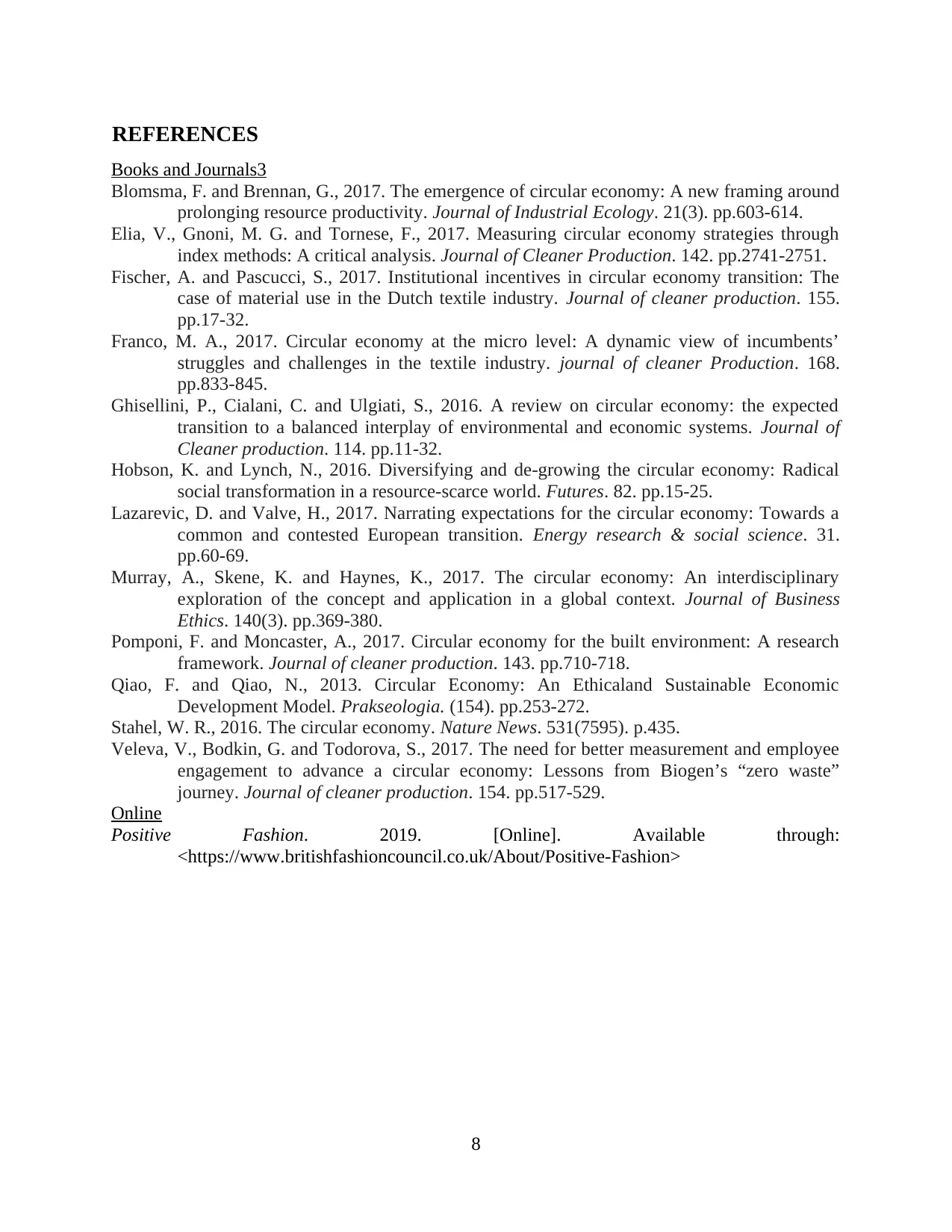
REFERENCES
Books and Journals3
Blomsma, F. and Brennan, G., 2017. The emergence of circular economy: A new framing around
prolonging resource productivity. Journal of Industrial Ecology. 21(3). pp.603-614.
Elia, V., Gnoni, M. G. and Tornese, F., 2017. Measuring circular economy strategies through
index methods: A critical analysis. Journal of Cleaner Production. 142. pp.2741-2751.
Fischer, A. and Pascucci, S., 2017. Institutional incentives in circular economy transition: The
case of material use in the Dutch textile industry. Journal of cleaner production. 155.
pp.17-32.
Franco, M. A., 2017. Circular economy at the micro level: A dynamic view of incumbents’
struggles and challenges in the textile industry. journal of cleaner Production. 168.
pp.833-845.
Ghisellini, P., Cialani, C. and Ulgiati, S., 2016. A review on circular economy: the expected
transition to a balanced interplay of environmental and economic systems. Journal of
Cleaner production. 114. pp.11-32.
Hobson, K. and Lynch, N., 2016. Diversifying and de-growing the circular economy: Radical
social transformation in a resource-scarce world. Futures. 82. pp.15-25.
Lazarevic, D. and Valve, H., 2017. Narrating expectations for the circular economy: Towards a
common and contested European transition. Energy research & social science. 31.
pp.60-69.
Murray, A., Skene, K. and Haynes, K., 2017. The circular economy: An interdisciplinary
exploration of the concept and application in a global context. Journal of Business
Ethics. 140(3). pp.369-380.
Pomponi, F. and Moncaster, A., 2017. Circular economy for the built environment: A research
framework. Journal of cleaner production. 143. pp.710-718.
Qiao, F. and Qiao, N., 2013. Circular Economy: An Ethicaland Sustainable Economic
Development Model. Prakseologia. (154). pp.253-272.
Stahel, W. R., 2016. The circular economy. Nature News. 531(7595). p.435.
Veleva, V., Bodkin, G. and Todorova, S., 2017. The need for better measurement and employee
engagement to advance a circular economy: Lessons from Biogen’s “zero waste”
journey. Journal of cleaner production. 154. pp.517-529.
Online
Positive Fashion. 2019. [Online]. Available through:
<https://www.britishfashioncouncil.co.uk/About/Positive-Fashion>
8
Books and Journals3
Blomsma, F. and Brennan, G., 2017. The emergence of circular economy: A new framing around
prolonging resource productivity. Journal of Industrial Ecology. 21(3). pp.603-614.
Elia, V., Gnoni, M. G. and Tornese, F., 2017. Measuring circular economy strategies through
index methods: A critical analysis. Journal of Cleaner Production. 142. pp.2741-2751.
Fischer, A. and Pascucci, S., 2017. Institutional incentives in circular economy transition: The
case of material use in the Dutch textile industry. Journal of cleaner production. 155.
pp.17-32.
Franco, M. A., 2017. Circular economy at the micro level: A dynamic view of incumbents’
struggles and challenges in the textile industry. journal of cleaner Production. 168.
pp.833-845.
Ghisellini, P., Cialani, C. and Ulgiati, S., 2016. A review on circular economy: the expected
transition to a balanced interplay of environmental and economic systems. Journal of
Cleaner production. 114. pp.11-32.
Hobson, K. and Lynch, N., 2016. Diversifying and de-growing the circular economy: Radical
social transformation in a resource-scarce world. Futures. 82. pp.15-25.
Lazarevic, D. and Valve, H., 2017. Narrating expectations for the circular economy: Towards a
common and contested European transition. Energy research & social science. 31.
pp.60-69.
Murray, A., Skene, K. and Haynes, K., 2017. The circular economy: An interdisciplinary
exploration of the concept and application in a global context. Journal of Business
Ethics. 140(3). pp.369-380.
Pomponi, F. and Moncaster, A., 2017. Circular economy for the built environment: A research
framework. Journal of cleaner production. 143. pp.710-718.
Qiao, F. and Qiao, N., 2013. Circular Economy: An Ethicaland Sustainable Economic
Development Model. Prakseologia. (154). pp.253-272.
Stahel, W. R., 2016. The circular economy. Nature News. 531(7595). p.435.
Veleva, V., Bodkin, G. and Todorova, S., 2017. The need for better measurement and employee
engagement to advance a circular economy: Lessons from Biogen’s “zero waste”
journey. Journal of cleaner production. 154. pp.517-529.
Online
Positive Fashion. 2019. [Online]. Available through:
<https://www.britishfashioncouncil.co.uk/About/Positive-Fashion>
8
1 out of 10
Related Documents
Your All-in-One AI-Powered Toolkit for Academic Success.
+13062052269
info@desklib.com
Available 24*7 on WhatsApp / Email
![[object Object]](/_next/static/media/star-bottom.7253800d.svg)
Unlock your academic potential
Copyright © 2020–2025 A2Z Services. All Rights Reserved. Developed and managed by ZUCOL.





